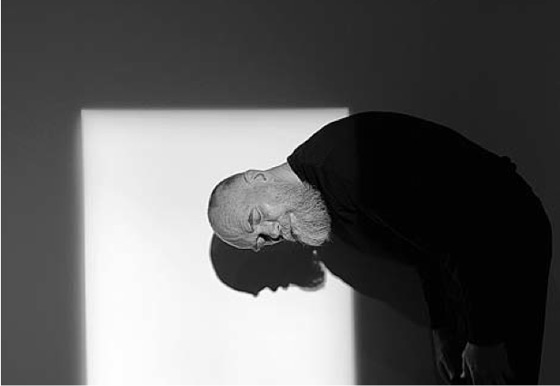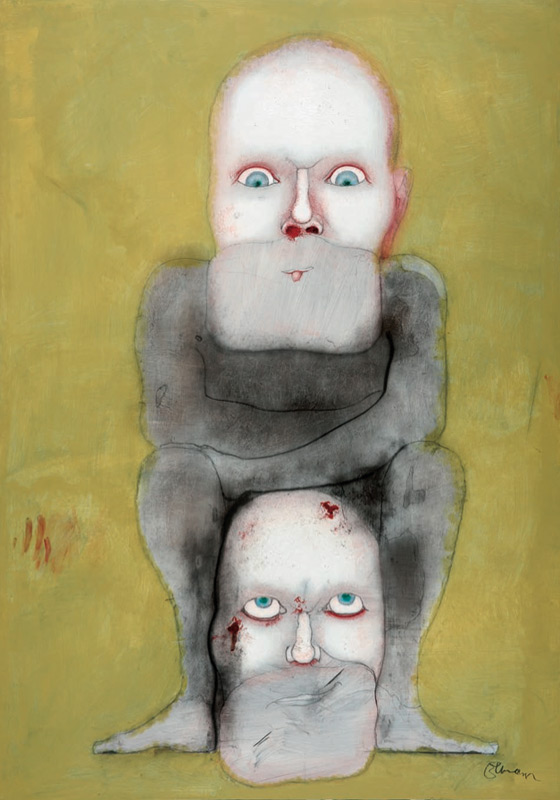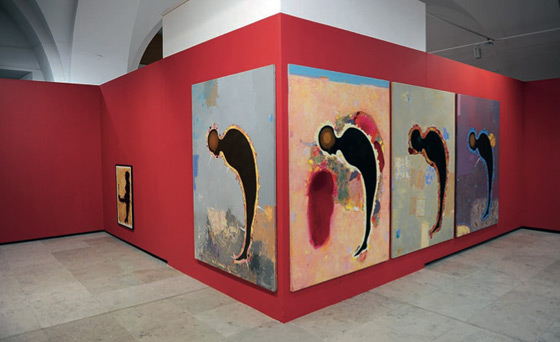|
|
| To be mortal and immortal at the same time Sniedze Sofija Kāle, Art Historian Ilmārs Blumbergs. I Won’t Die 16.08.–06.10.2013. Latvian National Museum of Art exhibition hall Arsenāls | |
| In Ancient Greece, one of the versions of the creation was associated with the existence of the original androgynous person, a creature which had both male and female nature. In Aristophanes’ retelling of Plato’s ‘Feast’, the said creatures were complete, because “terri- ble was their might and strength, and they made an attack upon the gods”(1). Zeus, unable to accept this kind of attitude, decided to make the androgynous creatures weaker, cutting each into two parts. From that moment on, the human being has been consumed by a longing to be unified again, or the desire to attain Eros. The gods are jealous of the complete and proud creations, simply because they have no justification for their existence. Furthermore, their self-sufficiency makes the interaction between the internal and the external world all the more difficult. Such a reference and reflections were summoned up by artist Ilmārs Blumbergs’ string of solo exhibitions I Won’t Die. First of all with the scope, taking over the only Latvian National Museum of Art (LNMA) venue currently available for displaying Latvian art at a national level – the Arsenāls exhibition hall and also Creative Workshop, as well as one of the most significant contemporary art galleries, Māksla XO. Then by its name, too, in which you can hear a scream of revolt against the given world order, denying the generally accepted maxim that “we are born and we die”. But it’s not that simple with the master’s art, as you can sense in places the playful and ironic rhythm of a waltz which, according to the principle of a game, brings in contradictions as well as paradoxes. For example, the exhibition’s title, to which the black figure Service in Barbed Wire standing in the vestibule acts as a counter argument. Once the world order has been overturned and the mortal creation has announced its immortality, the head is bowed and the helplessness of a person under various conditions is recognized. In addition, this black, hunched figure is a constant value that travels from one work to another, speaking of the human-like creature that has been cast into the Universe by circumstances, as well as the author’s enthusiasm for Eastern philosophy. The initial idea for the exhibition was to mark the artist’s 70th birthday, which was celebrated on 6 September. It would seem that the situation has been optimally exploited, and this pompous way of marking the birthday accepted with a certain irony. The result was a partly retrospective show which I’d prefer to call a slightly mystical solo exhibition with an autobiographical slant. The lead role was taken by Ilmārs Blumbergs himself, and his inspirational personal- ity which, for example, in the unbearable conditions of an exhibition opening can attract dozens of listeners and viewers to a talk, or invites you to watch as he unrolls a bundle of graphic artworks and recites captivating stories in a wise croaky voice. Thus it’s no wonder if at times there’s a suspicion that Latvia’s artistic elite has been taken over by blumbergmania, because, it seems, it wasn’t so long ago that his solo exhibition It’s raining! It’s raining! It’s raining! Buy pictures. Buy pictures! was to be seen at the LNMA Creative Workshop – just two years ago. His works can also be seen every so often in shows of collections and group exhibitions. Despite this, I Won’t Die ignores the author’s versatility and contribution to, for example, the posters and surrealist influenced prints created in the 1970s–1980s, as well as book illustrations and numismatic design, not to mention stage design. To a large extent this deficit is compensated by the recently released book, ‘Ilmārs Blumbergs. I Won’t Die’. | |
 Ilmārs Blumbergs. 2013 Photo from the private archive of Ilmārs Blumbergs | |
| The artist has made a conscious choice to disassociate himself from a full retrospective, instead concentrating on directly or metaphorically autobiographical works: graphic art, paintings, objects and unobtrusive installations – stagings. He transforms the white vaulted space into a labyrinth of experience where there’s no shortage of diverse surprises and dramatic effects, for example, a hole in a wall, or an unexpected noise, or unhung, propped up works, or drawings tied in closed books. These are the “hooks” so that the viewer, ambling through the staged exhibition, would collaborate and pose questions, and find answers as well. At that moment when the screaming red narrow tunnel and the grating yellow paintings become unbearable, there’s an opportunity to escape through a hole, or, when you’ve sunk into excessive seriousness and meditation, you’re surprised by a noise of unknown origin, but the unhung works remind you of the fact that the creative process has not yet finished. Whereas looking at the tied books, with the help of an intermediary, makes it into a special procession. In places, the exhibition’s scenographic effects decrease the solemnity of the works, but maybe it’s better that way, as even now, while he’s still alive, Ilmārs Blumbergs is in some circles addressed as “the master”, and such a classification has stuck fast, a complete opposite to the sensitivity and liveliness that his nature radiates. The following works could be considered to be the more concrete points of the autobiographical exhibition – witnesses to sud- den turns in the hidden journey through life, for example, Denial of the Mother, The Meeting Happened in Silence, Devotion, Incident by the Open Window, My Head in a Strontium Glow and others. The most nuanced series of paintings in terms of mood, Snowing all the Time, tells us of the artist’s sojourn in Siberia, and no matter how true his experience may have been, this destination is such a mythologized theme in Latvia that, whether you want to or not, it develops into a generalization and, despite the memories of childhood which are touched more by experiences than feelings, it takes on a mood of suffering. The second series is made up of partly mystical self-portraits, expressing indefinable feelings and an emotional attitude, for the main part making use of irony (Self Portrait on a Pan, Self Dressed as Rembrandt, Everything is Self and the I Won’t Die series), self-denial and an awareness of being imprisoned (Face With a Blow on the Right Side and the The Same series). The third series encompasses daily observations of the divine, or the awareness of beauty in simple “things” by a person who is open to the world: the sea, a mountain or light against the background of a wall. In contrast to the generalization, a number of paintings address certain appeals or slogans, like an echo from the flower child culture widespread in his youth (Milk Yourself; Friend Seeking Gems! ; Add my Ashes and Make a Painting, Scatter the Rest in the Sea; People Don’t Change They Die) which, by using paradox, invite one to an internal revolution with hippy-like peaceableness. One of the most “Blumberg-like” characteristics moves across the titles and series, from work to work – this is a particularly brutal attitude to the human body, subjecting it to paint smears, deformations, bloody stains, cuts, splattering, stabbings and crushing. The individual freedom won during his youth in the 1960s and the tension created through bodily self-manifestation is most likely to blame for the use of an arsenal worthy of the Holy Inquisition. This is expressed at a higher degree in the video which can be viewed on the second floor, as well as in the performances of contemporaries, for example, Herman Nitsch, Vito Acconci and others, which at the same time represent the destruction of the figure of art in the body. An- other explanation for such a dramatic clash between the human and the environment could be guessed at in the fact that Blumbergs’ art is theatrical – in it you can always find someone on whom the power created by destiny, the gods, natural law or some other source is op- erating, and a concentrated exchange of impulses is taking place. | |
 Ilmārs Blumbergs. Everything for Sale. Charcoal, acrylic, cardboard. 150x100 cm. 2012–2013 Publicity photo Courtesy of the artist | |
| In thinking about the art of the master as a whole, one cannot get far away from Ancient Greece. In this culture, the theatre, as in Ilmārs Blumbergs’ art, is a way of playing out the relationship between the gods and humans, where, by surviving curses and succumbing to the blows of destiny, one can reach self-awareness and revelations. The artist uses the myths of Ancient Greece quite directly as well – they have been present at all phases of his life, in creating stage designs for performances, and drawing illustrations, and in painting. In addition, Blumbergs tends to break down the boundaries between the experienced and the imagined and, using this confusing method, irritates the “authenticity gene” worshipped in contemporary society. For example, in the excursion at the exhibition opening, he “lied” straight to our faces, many dozens of patient listeners, telling us about a work which was removed by the curator, or about paintings which were created at other times, as opposed to their real dates. In spite of 20th century attempts in art, it’s difficult to forgo a proper story with an introduction, discussion and an end. In reality, an articulate world is based only on narrative, which is managed in the most filigree way by directors, stage designers and other writers, and which settles most easily in the consciousness, linking the concrete with the abstract. Just as masterfully, Blumbergs is able to interchange the mortal and the immortal, both thematically (Outside of Time; Not Finished Work; and the Light on a Wall with a Painting of the Sea series), as well as formally, when unexpected detail and scrupulousness, with the assistance of textures and contours, is set against a generalized form, background or emptiness. Obviously, the highest level can be enjoyed in the drawings displayed in the Creative Workshop, where the base and the image create a subtle movement – images strike out from the texture of the paper and gain a wobbly, barely perceptible border, hiding within a cloak of grey mystery. | |
 Ilmārs Blumbergs. View from the exhibition I Won’t Die. 2013 Publicity photos Courtesy of the artist | |
| The use of coincidence is yet another of the strategies used by the artist, but his deliberately-created game, or the exhibition’s overall staging, is what is the most compelling. The author uses halftruths, long pauses and personal stories which haven’t been told in full, but at the same time he doesn’t lose his sense of humour, reminding us that the main goal of art is to involve us in an experience, without it turning into religious fanaticism. The presentation of the artistic process – this is the most compelling achievement of the I Won’t Die exhibition, as Ilmārs Blumbergs has been able to draw the viewer into a zone where human strength alternates with a sense of defeat, focussing on his existence in the cycle of the Universe. Returning to Plato cited in the introduction, the realization expressed at its conclusion, that “mortal nature tries as it may, to be eternal and immortal, but it can only achieve this by giving birth, only by leaving something new in place of the old” must be highlighted(2). In this way, a person becomes immortal, bringing descendants into the world or – even better – giving birth to kindred spirits. One must conclude that the artist is right: looking at it through ancient Greek ideals, he has already become immortal, as, thanks to Eros, he creates that which makes us more beautiful and complete. Translator into English: Uldis Brūns (1) Platons. Menons. Dzīres. Rīga: Zvaigzne, 1980, p. 77. (2) Ibid, p. 94. | |
| go back | |







